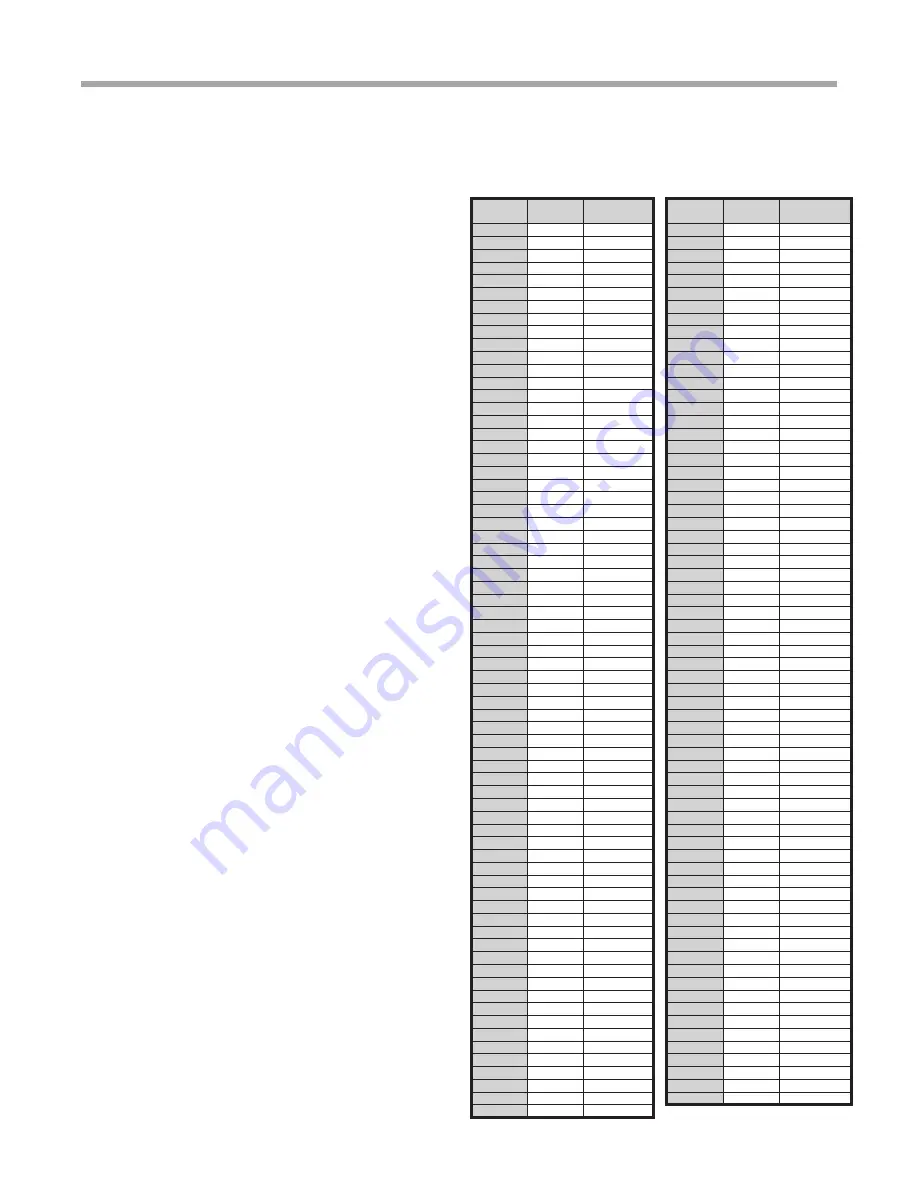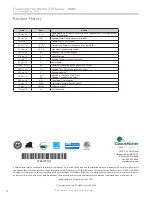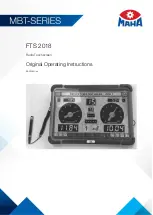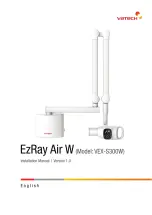
60
G e o t h e r m a l H e a t i n g a n d Co o l i n g
Tranquility
®
22 Digital (TZ
)
Series - 60Hz
R e v. : N o v e m b e r 1 8 , 2 0 2 2
Troubleshooting
Table 17: Nominal resistance at various temperatures
Temp (ºC) Temp (ºF) Resistance
(kOhm)
Temp (ºC) Temp (ºF) Resistance
(kOhm)
-17.8
0.0
85.34
55
131.0
2.99
-17.5
0.5
84.00
56
132.8
2.88
-16.9
1.5
81.38
57
134.6
2.77
-12
10.4
61.70
58
136.4
2.67
-11
12.2
58.40
59
138.2
2.58
-10
14.0
55.30
60
140.0
2.49
-9
15.8
52.38
61
141.8
2.40
-8
17.6
49.64
62
143.6
2.32
-7
19.4
47.05
63
145.4
2.23
-6
21.2
44.61
64
147.2
2.16
-5
23.0
42.32
65
149.0
2.08
-4
24.8
40.15
66
150.8
2.01
-3
26.6
38.11
67
152.6
1.94
-2
28.4
36.18
68
154.4
1.88
-1
30.2
34.37
69
156.2
1.81
0
32.0
32.65
70
158.0
1.75
1
33.8
31.03
71
159.8
1.69
2
35.6
29.50
72
161.6
1.64
3
37.4
28.05
73
163.4
1.58
4
39.2
26.69
74
165.2
1.53
5
41.0
25.39
75
167.0
1.48
6
42.8
24.17
76
168.8
1.43
7
44.6
23.02
77
170.6
1.39
8
46.4
21.92
78
172.4
1.34
9
48.2
20.88
79
174.2
1.30
10
50.0
19.90
80
176.0
1.26
11
51.8
18.97
81
177.8
1.22
12
53.6
18.09
82
179.6
1.18
13
55.4
17.26
83
181.4
1.14
14
57.2
16.46
84
183.2
1.10
15
59.0
15.71
85
185.0
1.07
16
60.8
15.00
86
186.8
1.04
17
62.6
14.32
87
188.6
1.01
18
64.4
13.68
88
190.4
0.97
19
66.2
13.07
89
192.2
0.94
20
68.0
12.49
90
194.0
0.92
21
69.8
11.94
91
195.8
0.89
22
71.6
11.42
92
197.6
0.86
23
73.4
10.92
93
199.4
0.84
24
75.2
10.45
94
201.2
0.81
25
77.0
10.00
95
203.0
0.79
26
78.8
9.57
96
204.8
0.76
27
80.6
9.16
97
206.6
0.74
28
82.4
8.78
98
208.4
0.72
29
84.2
8.41
99
210.2
0.70
30
86.0
8.06
100
212.0
0.68
31
87.8
7.72
101
213.8
0.66
32
89.6
7.40
102
215.6
0.64
33
91.4
7.10
103
217.4
0.62
34
93.2
6.81
104
219.2
0.60
35
95.0
6.53
105
221.0
0.59
36
96.8
6.27
106
222.8
0.57
37
98.6
6.01
107
224.6
0.55
38
100.4
5.77
108
226.4
0.54
39
102.2
5.54
109
228.2
0.52
40
104.0
5.33
110
230.0
0.51
41
105.8
5.12
111
231.8
0.50
42
107.6
4.92
112
233.6
0.48
43
109.4
4.72
113
235.4
0.47
44
111.2
4.54
114
237.2
0.46
45
113.0
4.37
115
239.0
0.44
46
114.8
4.20
116
240.8
0.43
47
116.6
4.04
117
242.6
0.42
48
118.4
3.89
118
244.4
0.41
49
120.2
3.74
119
246.2
0.40
50
122.0
3.60
120
248.0
0.39
51
123.8
3.47
121
249.8
0.38
52
125.6
3.34
122
251.6
0.37
53
127.4
3.22
123
253.4
0.36
54
129.2
3.10
GENERAL
If operational difficulties are encountered, perform
the preliminary checks below before referring to the
troubleshooting charts.
• Verify that the unit is receiving electrical supply power.
• Make sure the fuses in the fused disconnect switches
are intact.
After completing the preliminary checks described above,
inspect for other obvious problems such as leaking
connections, broken or disconnected wires, etc. If everything
appears to be in order, but the unit still fails to operate
properly, refer to the “DXM2.5 Functional Troubleshooting
Flow Chart” or “Functional Troubleshooting Chart.”
DXM2.5 BOARD
DXM2.5 board troubleshooting in general is best summarized
as verifying inputs and outputs. After inputs and outputs
have been verified, board operation is confirmed and the
problem must be elsewhere. Below are some general
guidelines for troubleshooting the DXM2.5 control.
FIELD INPUTS
Conventional thermostat inputs are 24VAC from the
thermostat and can be verified using a voltmeter between C
and Y1, Y2, W, O, G. 24VAC will be present at the terminal
(for example, between “Y1” and “C”) if the thermostat is
sending an input to the DXM2.5 board.
Proper communications with a thermostat can be verified
using the Fault LED on the DXM2.5. If the control is NOT in
the Test mode and is NOT currently locked out or in a retry
delay, the Fault LED on the DXM2.5 will flash very slowly
(1 second on, 5 seconds off), if the DXM2.5 is properly
communicating with the thermostat.
SENSOR INPUTS
All sensor inputs are ‘paired wires’ connecting each
component to the board. Therefore, continuity on pressure
switches, for example can be checked at the board
connector. The thermistor resistance should be measured
with the connector removed so that only the impedance
of the thermistor is measured. If desired, this reading can
be compared to the thermistor resistance chart shown in
Table 17. An ice bath can be used to check the calibration
of the thermistor.













































